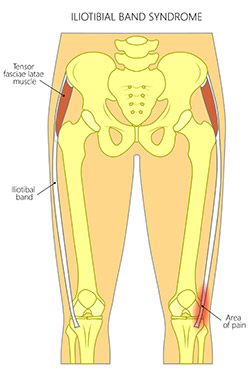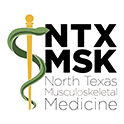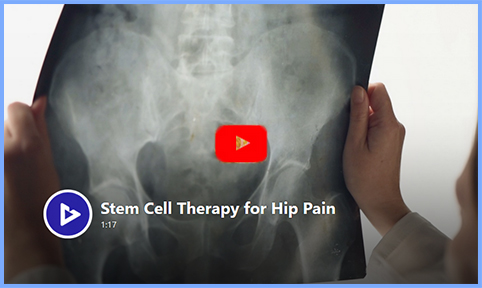Hip Conditions

The thigh bone and pelvis join to form this versatile ball and socket joint. Muscles, ligaments, and tendons contribute to stabilizing the joint. Ligaments are fibrous structures that connect bones to other bones. The hip joint is encircled with ligaments that provide stability by forming a dense and fibrous structure around the joint capsule called the labrum. Athletes who participate in sports such as hockey, soccer, football, golf and ballet are at higher risk of developing a tear in the labrum. The labrum also functions to cushion the joint.
Articular cartilage, a thin, tough, flexible tissue surrounds the ball portion of the hip joint. It is lubricated by synovial fluid, much like oil lubricates a car engine. When synovial fluid is reduced with age, this tissue wears thin and arthritis occurs from resulting friction and inflammation.
Treatment
Osteopathic Manipulative Treatment (OMT) is particularly effective in tight or spasmodic conditions of the muscles and connective tissues, allowing them to return to normal function and relieve pain. With impingements removed, body fluids flow more freely to nourish and heal painful tissue.
 Regenerative Procedures accelerate and enhance your natural healing process. Platelet Rich Plasma Therapy (PRP) and Stem Cell Therapy supply autologous healing cells to areas of the body that have difficulty healing on their own due to poor blood supply or where healing cells are limited from chronic injury or aging. Blood flow to the affected area is increased, removing damaged tissue and supplying cells necessary to the healing process.
Regenerative Procedures accelerate and enhance your natural healing process. Platelet Rich Plasma Therapy (PRP) and Stem Cell Therapy supply autologous healing cells to areas of the body that have difficulty healing on their own due to poor blood supply or where healing cells are limited from chronic injury or aging. Blood flow to the affected area is increased, removing damaged tissue and supplying cells necessary to the healing process.
Regenerative procedures are beneficial for athletes or anyone who experiences microtears in the labrum or painful arthritis resulting from reduced articular cartilage in the joint. Regenerative procedures directly supply healing cells needed for faster, more complete healing.

Regenexx is a world-wide network of select, highly skilled physicians who are specially trained in interventional procedures for orthopedic conditions. Regenexx provides the world's most advanced, research-driven, regenerative orthopedic procedures in North America, Europe, the Middle East, Asia and Australia. Specializing in advanced non-surgical procedures for joint Injuries, osteoarthritis, and other orthopedic conditions, Dr. Minotti brings these procedures to you!
To determine if Regenerative Orthopedics will be helpful for you, please tell us about your condition.
View live results from Regenexx registry.
Common conditions of the hip

Osteoarthritis. Osteoarthritis is one of the most common causes of chronic hip pain for both athletes and non-athletes alike. It is characterized by damaged articular cartilage that lines the hip joint. Over time, the smooth, protective cartilage of the hip socket wears down and bare bone is exposed, making movement painful. Osteoarthritis is an active disease process that causes degeneration of the cartilage surface. Regenerative procedures offer an alternative to joint replacement and harmful steroids.
Groin pulls and strains. Hip and groin disorders are more common in athletes and generally caused by rapid acceleration and deceleration motions. The connecting tissues are stretched beyond their limits, resulting in small tears that cause pain and swelling. The rehabilitation time for hip and groin injuries are longer than most other injuries, making early and accurate diagnosis essential.
Iliotibial band syndrome. Iliotibial (IT) band syndrome is an overuse injury resulting in the inflammation of the thick band of fibrous tissue that begins at the iliac crest of the hip and runs along the outside of the thigh. The band attaches to the outer side of the shin bone just below the knee joint. Its function is to coordinate with the thigh muscles and provide stability to the knee. Iliotibial band syndrome occurs when the IT band and the lower outside portion of the thighbone rub against each other. It commonly occurs in athletes, cyclists, and runners. Knee pain from this injury is most commonly felt along the outside of the knee and lower thigh. IT band syndrome may also result in a nagging or acute pain on the outside of the hip.
Trochanteric bursitis. Greater trochanter bursitis, also called hip bursitis, is a condition caused by inflammation of the bursa that overlies the greater trochanter (bony prominence at the outer side of the hip). A bursa is a small sac filled with fluid that acts as a cushion and allows smooth motion by reducing the friction between the muscles and the bone. The condition causes pain in the outer portion of the upper thigh. It is commonly seen in runners due to overuse, but can also be caused by a fall or other impact. Patients who have had surgery for repair of hip fracture or hip replacement also experience bursitis.
Piriformis syndrome. The piriformis muscle is a small muscle in the groin that runs from the sacrum to the outer hip bone. When the piriformis muscle becomes tight or cramps, it can put pressure on the sciatic nerve that passes underneath it. Typically, this pain increases when the muscle contracts, when sitting for an extended time, or with direct pressure on the muscle. Gluteal pain is common. Pirformis syndrome is also a common cause of sciatica.
We Can Help
To learn more about what we can do to help you, please call our office at 817-416-0970. We will thoroughly diagnose your condition and present you with treatment options. From there we will guide you along your road to recovery.

